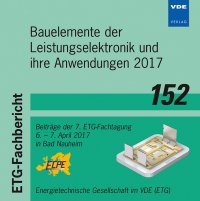Last Advances in Electrolytic and Film Capacitors for Power Electronics
Konferenz: Bauelemente der Leistungselektronik und ihre Anwendungen 2017 - 7. ETG-Fachtagung
06.04.2017 - 07.04.2017 in Bad Nauheim, Deutschland
Tagungsband: Bauelemente der Leistungselektronik und ihre Anwendungen 2017
Seiten: 5Sprache: EnglischTyp: PDF
Persönliche VDE-Mitglieder erhalten auf diesen Artikel 10% Rabatt
Autoren:
Auer, Christoph (CAP ALU RD EPCOS Kft, A TDK Group Company Szombathely, Hungary)
Schöll, Sebastian (CAP ALU RD D/A EPCOS AG, A TDK Group Company Munich, Germany)
Cabo, Lucia (CAP FILM T RD BR EPCOS AG, A TDK Group Company Munich, Germany)
Rodriguez, Fernando (CAP FILM T RD PD PEC HP EPCOS ELECTRONIC COMPONENTS SA, A TDK Group Company Malaga, Spain)
Inhalt:
The requirements for passive components in power electronics are mainly ruled by the capabilities of the semiconductor technology [1]. The evolution into faster devices, with higher current handling, voltage ratings and operation temperature is a reality with the upcoming SiC and GaN technology. Semiconductor devices based on SiC are also able to switch ten times faster than the equivalent silicon based semiconductors [2-4]. As a direct consequence, capacitors designed to work in SiC based converters will be required to have high current density capability, and very low and homogeneously distributed inductance. Another advantage of SiC semiconductors is that they can operate at up to 400 °C and they have three times higher thermal conductivity as Si semiconductors [2]. In order to take complete advantage of the high operation temperature it is as well desirable that the maximum allowable temperature on the passive components, specifically the capacitors, has to be increased. In general, due to the evolution of the semiconductors in the last years and a qualitative step forward coming up with the wide-bandgap semiconductor technology the power capacitors are required to have more compact and cheap designs, with high energy density and current handling capability and able to operate at high frequencies. The resulting heat generation and operating conditions should be carefully studied in the design-in phase. In this article, relevant design considerations on the equivalent series resistance and inductivity in aluminum electrolytic and film capacitors that have major impact in the long term reliability and lifetime are discussed.


